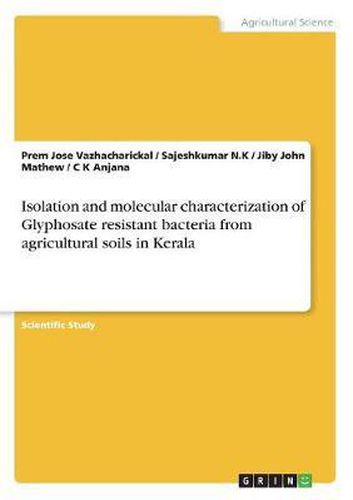Readings Newsletter
Become a Readings Member to make your shopping experience even easier.
Sign in or sign up for free!
You’re not far away from qualifying for FREE standard shipping within Australia
You’ve qualified for FREE standard shipping within Australia
The cart is loading…






Scientific Study from the year 2016 in the subject Agrarian Studies, grade: 1.5, Mar Augusthinose College, language: English, abstract: Glyphosate (N-phosphonomethylglycine) is a herbicide that is used worldwidely. Its common trade name is Roundup. Its non-targeted species action makes it most popular herbicide. It was developed by Monsanto company. The primary target for glyphosate is the enzyme EPSPS (5-enolpyruvoylshikimate 3-phosphate synthase). When glyphosate binds to EPSPS it forms a very stable complex that essentially permanently disables the enzyme and hence affect the metabolic activity of the plant and results in its death. Finding Glyphosate degrading microorganisms from soil is an interesting topic since glyphosate is non- targeted in its toxicity. Microorganisms were isolated from soil samples, which were then identified by molecular method. Isolation of DNA, its amplification using 16s rRNA gene and its sequencing are the major steps involved. Bioinformatics tool helps to identify the microorganisms. Two microorganisms identified are Pseudomonas sp. and Achromobacter sp. In the phylogenetic analysis also the two organisms are grouped as separate clads. In these, strain 1 showed highest growth in the Glyphosate containing medium than strain 2. These results show that the bacterial strain may possess potential to be used in bioremediation of glyphosate-contaminated environments.
$9.00 standard shipping within Australia
FREE standard shipping within Australia for orders over $100.00
Express & International shipping calculated at checkout
Scientific Study from the year 2016 in the subject Agrarian Studies, grade: 1.5, Mar Augusthinose College, language: English, abstract: Glyphosate (N-phosphonomethylglycine) is a herbicide that is used worldwidely. Its common trade name is Roundup. Its non-targeted species action makes it most popular herbicide. It was developed by Monsanto company. The primary target for glyphosate is the enzyme EPSPS (5-enolpyruvoylshikimate 3-phosphate synthase). When glyphosate binds to EPSPS it forms a very stable complex that essentially permanently disables the enzyme and hence affect the metabolic activity of the plant and results in its death. Finding Glyphosate degrading microorganisms from soil is an interesting topic since glyphosate is non- targeted in its toxicity. Microorganisms were isolated from soil samples, which were then identified by molecular method. Isolation of DNA, its amplification using 16s rRNA gene and its sequencing are the major steps involved. Bioinformatics tool helps to identify the microorganisms. Two microorganisms identified are Pseudomonas sp. and Achromobacter sp. In the phylogenetic analysis also the two organisms are grouped as separate clads. In these, strain 1 showed highest growth in the Glyphosate containing medium than strain 2. These results show that the bacterial strain may possess potential to be used in bioremediation of glyphosate-contaminated environments.